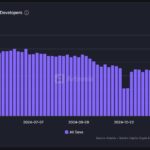In a recent report, investment bank Standard Chartered has generated considerable buzz in the cryptocurrency world by initiating coverage of XRP, the digital token linked to Ripple. The report suggests an optimistic trajectory for XRP, predicting that the token could soar to $12.50 before the end of Donald Trump’s presidential term. Currently trading at approximately $1.94, XRP has already seen a significant surge of nearly 9% recently. According to the bank’s forecast, XRP is expected to reach $5.50 by the end of this year and could hit $8 by 2026.
Standard Chartered credits the anticipated rise of XRP to several factors, including a notable historical spike in value following Trump’s election victory in 2016 and the ongoing speculation that the Securities and Exchange Commission (SEC) might soon discontinue its legal challenges against Ripple. The potential approval of XRP exchange-traded funds (ETFs) also plays a part in this bullish sentiment. Geoffrey Kendrick, the bank’s head of digital assets research, emphasized that XRP’s unique positioning in facilitating cross-border payments aligns with one of the fastest-growing trends in digital finance.
“XRPL is similar to the main use case for stablecoins such as Tether: blockchain-enabled financial transactions that have traditionally been done through traditional financial (TradFi) institutions,” Kendrick stated.
The report further highlights that stablecoin transactions, which are critical for international money transfers and cryptocurrency markets, are projected to increase tenfold over the next four years. Ripple is keen on expanding the applications of its technology, with plans to venture into the promising realm of tokenization, further diversifying the use of XRP’s decentralized public blockchain, XRPL.
Despite acknowledging some challenges, such as a limited developer community and constrained value capture, Standard Chartered asserts that the upward momentum for XRP is supported by substantial positive developments. These advancements may allow XRP to keep pace with the broader cryptocurrency market and its dominant counterpart, Bitcoin (BTC).
As the cryptocurrency landscape continues to evolve, XRP’s journey remains of keen interest to investors and enthusiasts alike, particularly in light of the upcoming developments surrounding regulatory decisions and market innovations.

XRP Price Predictions and Market Insights
The report by Standard Chartered highlights significant predictions for XRP’s price trajectory and its role in the evolving cryptocurrency landscape.
- Price Forecasts:
- XRP is expected to reach $5.50 by the end of 2023.
- Projected price of $8 by the end of 2026.
- Anticipated value of $10.40 by the end of 2027.
- Long-term prediction suggests reaching $12.50 by the end of 2028.
- Impact of Leadership at SEC:
- XRP’s price rose significantly following Trump’s election due to expectations of regulatory changes.
- Leadership changes at the SEC could influence the approval of XRP-related ETFs.
- XRP’s Unique Market Position:
- XRP is positioned in the fast-growing sector of cross-border and cross-currency payments.
- The underlying technology (XRPL) aims to facilitate efficient financial transactions similar to stablecoins.
- Growing Importance of Stablecoins:
- Stablecoin transactions are projected to increase tenfold in the next four years.
- Stablecoins like Tether play a crucial role in international money transfers and cryptocurrency markets.
- Potential and Challenges of XRPL:
- Despite having a limited number of developers and value capture issues, positive market conditions bode well for XRP.
- Ripple’s intention to expand into tokenization could enhance the utility of XRPL.
- Relation to Bitcoin:
- Standard Chartered believes XRP’s price appreciation will keep pace with Bitcoin (BTC), enhancing investor interest.
“XRPL is similar to the main use case for stablecoins such as Tether: blockchain-enabled financial transactions that have traditionally been done through traditional financial (TradFi) institutions.” – Geoffrey Kendrick, Standard Chartered
XRP Price Predictions and Market Dynamics: A Comparative Analysis
The recent report from Standard Chartered on XRP highlights some intriguing potential price movements, predicting a rise to $12.50 by the end of Donald Trump’s tenure. This forecast positions XRP as a compelling investment, especially given the bank’s estimate of $5.50 by year-end and progressively higher targets leading up to 2028. The speculation around XRP’s future resonates with a growing trend in the cryptocurrency market, particularly in relation to digital assets aimed at facilitating cross-border payments.
While XRP’s projected growth is promising, it’s essential to compare these prospects with other blockchain-centric assets, such as various stablecoins and leading cryptocurrencies like Bitcoin (BTC). One notable advantage for XRP is its unique position in cross-border transactions, similar to stablecoins like Tether, which have gained traction for facilitating quicker and more cost-effective financial transfers. The increasing use of stablecoins may create a synergistic effect for XRP, especially as transaction volumes are expected to soar in the coming years. Moreover, the anticipated regulatory shifts at the SEC could pave the way for a more favorable environment for XRP and its associated technologies like XRPL.
However, there are notable concerns surrounding XRP that could hinder its performance. The cryptocurrency has a relatively small developer ecosystem, which may limit innovation and adaptability in a rapidly evolving market. Furthermore, its current value capture is less robust than that of its larger counterparts like BTC, raising questions on its sustainability and long-term growth potential. These limitations could deter cautious investors seeking stability in their portfolios or those wary of high-risk ventures in the crypto space.
The implications of XRP’s growth and the favorable outlook from Standard Chartered might benefit a wide array of participants in the financial landscape. For investors, this presents an opportunity to capitalize on an undervalued asset poised for expansion, especially if tokens like XRP secure ETF approval in the U.S. Conversely, traditional financial institutions might need to address the increased competition posed by cryptocurrencies in cross-border payment solutions. The emergence of XRP and its use cases could also spark regulatory scrutiny, impacting established players in the financial sector who may feel threatened by the rise of decentralized finance solutions.
As the market continues to evolve, those with a vested interest in digital finance—be it through investing or providing traditional financial services—should closely monitor XRP’s trajectory and the broader implications of its market positioning against its competitors.

















